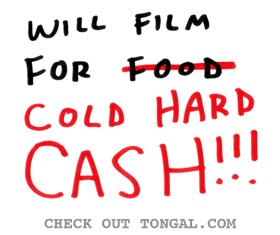For years I have been lighting my video contest entries with a pair of giant, 1,000 watt halogen lights with enormous “soft boxes” attached to them. But frankly, those lights suck. The bulbs get so hot that the lights have fans inside of them! The fans are so loud that I’m always worried the mic will pick up the whirring sound they make. And anyone who has ever put together a soft box can tell you, they’re a pain to set up and move. Worst of all though, 1,000 watt bulbs aren’t easy to find. The ones I used cost about 16 bucks each and I used to break them all the time. Since you can’t just pick these bulbs up at your local home depot, I had to order them special online. But recently, the company that sold me my light kit stopped carrying the bulbs! They sold me their last two and said they don’t even know where I could find more of them.
So I took that as a sign that it was time to get some decent lights. I did some research and decided to spend a little cash and buy my first . And let me tell you something…these things are pretty sweet. In fact, I used my new LED light on one shoot and the very next day I ordered a second one. Here’s why these things are so amazing:
1. The panels put out the equivalent of 500 watts of light but only use 50 watts of energy. So you’re probably not going to be tripping any breakers with these.
2. The light is so simple you could set it up in seconds.
3. The LED panel is so small you could stick it in a back pack.
4. The light emits pure white.
5. The LED bulbs stay cool to the touch.
6. There are separate switches on the back for different sections of the panel. So basically, it comes with a “dimmer.”
7. They’re so small you can fit one in a back pack.
8. The look pretty cool.
And yes, “looking cool” is an important feature. When you’re working on a low-budget video project, I think a professional atmosphere is good for the moral of the cast and crew. So I really like these lights. But they do have a few problems:
1. They’re not cheap. These lights cost me $179 each. You can order them , BTW.
2. The light they emit is incredibly STARK. They have zero warmth to them. You’ll need to carefully white balance and color correct your footage so it doesn’t look like you shot it in a prison.
3. The lights I ordered didn’t come with stands. You’ll need to order them separately. works fine.
4. Even on the lowest setting, the lights give off strong shadows. You’ll need to diffuse the light somehow.
To be honest, at first these lights were kind of frustrating Sometimes they would work great and sometimes the looked like crap. It took me a little trial and error but I think I’ve finally gotten the hang of them. I’ll throw one more numbered list at you. Here are some tips for getting better footage out of your LED panels.
1. Buy two of them. Trust me, they work better in pairs.
2. Set them up far from the subject. The farther away the lights are, the better. If you put them to close it will look like you’re shooting a horror movie.
3. Use to diffuse the light. Wax paper or Parchment paper should help too.
4. Crank the lights up as bright as they go and then bounce the light off a ceiling or wall.
5. Use them with natural sunlight!
I’ve found that these LED panels work great when you have some natural sunlight in your scene. If an open window is your main light source, you can use the light to fill in the shadows. Seriously, it works like a charm since the sun and the LEDs are the same “color temperature.” Here’s an example of what I’m talking about. Below is my entry for Home Run Inn Pizza’s Halloween video contest. People were supposed to create scary stories that involved HRI Pizza. I lit this whole scene with 2 LED panels and the sun. And I mean every shot in this video was lit with the LED lights; even the wide shot of the exterior of the house:
Click the image to watch...if you dare.
To a causal viewer, the lighting in this video would probably seem totally natural. But trust me, without the LED panels it would have looked like garbage. Take the shot of the ghost for example. You can see that the sunlight is coming from behind him. So without an LED light shining right on him, his front would have been totally dark. But I didn’t need to bathe the guy in artificial light. I only had the LED panel on at about 30%. And check out the shot of the skeleton in the kitchen. Most of the light in that scene was coming from the kitchen window. But the LED was able to fill in the shadows that the sun created.
Ok, sure…I know that there are a lot of lights that could yield similar results. I could have stuck a 300 Watt bulb in a paper “china ball” lantern and the effect would be about the same. But the LED panels are a lot more precise and you can “sculpt” the light since the panels have barn doors on them. Plus, a gigantic China Ball can’t fit in tight spaces like the LED panel can. So if you have a few hundred bucks burning a hole in your pocket, I suggest ordering an LED panel and trying it out. After you get the hang of it you’ll want to stick it in a bag and bring it to every shoot you do.
Oh by the way…did you see what I did there when I used my Home Run Inn pizza video as an example? It was my crass attempt to get a few votes for my entry. Voting in that contest runs until the 27th and to vote, all you have to do is log in to facebook and click the vote button. So please do vote if you have 15 seconds to spare. If I get in the top 15, I’ll win free pizza for a year! Also, be sure to watch the video. Views don’t matter, I just think it’s pretty funny.









